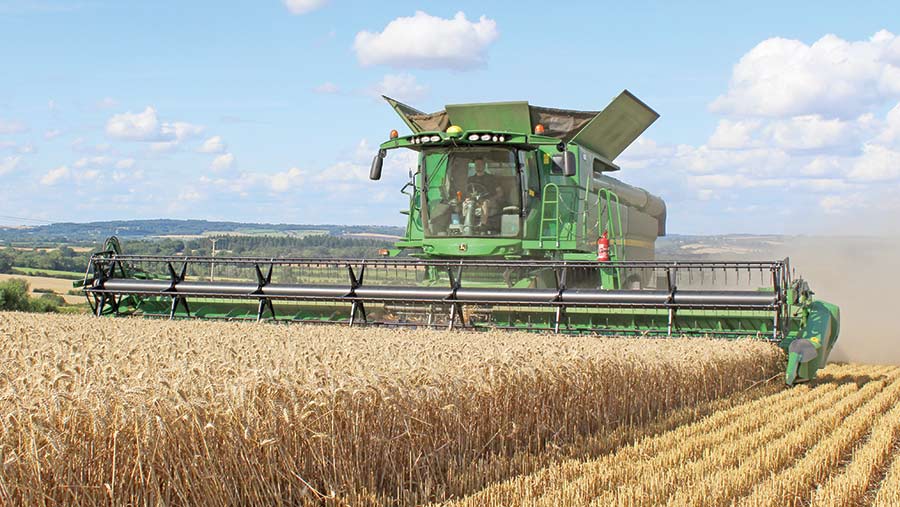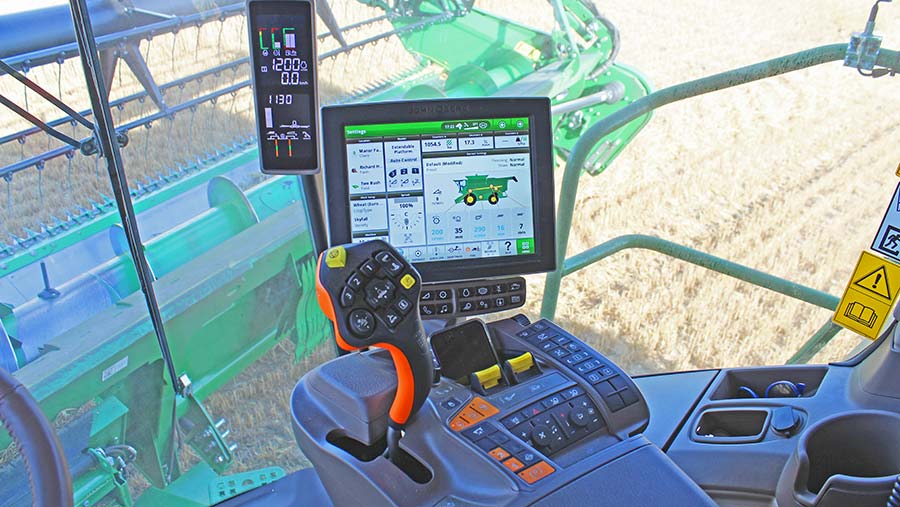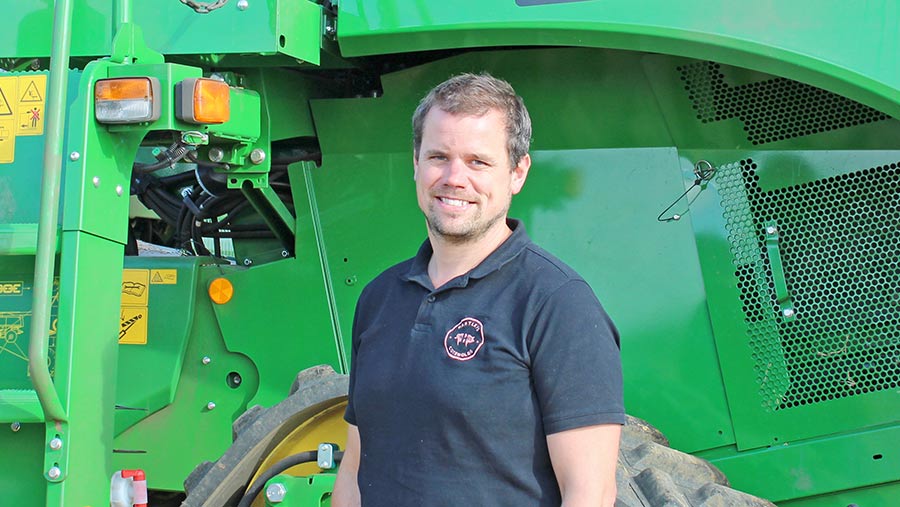Driver’s view: Nick Brown’s John Deere S790i combine

The biggest combine in John Deere’s line-up is the S790i, featuring a 617hp, six-cylinder engine, single rotor threshing mechanism and various header options up to 12.2m wide.
It replaced a Case-IH Axial-Flow 9230 and after a number of different demos, the company settled on the green and yellow machine.
We get the lowdown on the performance of a 2018 machine run by 970ha Oxfordshire farming partnership Manor Farms and find out if they would have another when this one comes up for replacement.
What made you choose a John Deere S790i?
In the summer of 2017 we had demonstrations of all the major combine brands and the John Deere stood out as a very impressive machine.
The cab, controls and guidance integration seemed ahead of the competition and it was a significant step up from the Case-IH Axial Flow 9230 we had before.
We were still open to most brands if the deal was right, but John Deere provided a competitive financial package that was hard to beat.
See also: John Deere announces 2020 combine updates
After weighing up the options, we decided it was more cost effective to lease the combine on a five-year deal, rather than buying it.
As Manor Farms is run as a partnership between the Hartley and Pearce families, this also made the administration a little easier.
The partnership has no equity in the machine, but it has halved our combining cost from £87.77/ha in harvest 2017 to £39.73/ha last year.
It also has a full maintenance and servicing plan in place, which has given us confidence and peace of mind throughout the harvest.
John Deere S790i vital stats
- Year 2018
- Hours worked (threshing) 360 hours
- Tracks John Deere suspended
- Engine John Deere 13.5-litre six-cylinder
- Rated power 617hp
- Header 635X 10.7m (35ft)
- Threshing system Single rotor
- Rotor dimensions Length: 3,124mm, diameter: 762mm
- Grain tank capacity 14,100 litres
- Output Up to 75t/hour
- Unloading speed 135 litres/s
- List price £572,198
How has it performed?
The combine is now well into its second season and we have been impressed with its performance.
When working in wheat, we can generally cruise along at about 6kph in an average crop, with work rates up to 75t/hour. Our average field size is fairly reasonable at about 14ha, so on a good day we can cut about 60ha.
We carry out benchmarking with the Joint Venture Farming Group – which includes 11 farming businesses covering over 16,000ha across England – and last year our S790i won the Harvest Cup, with the best output versus cost per hectare.
To help get the most out of our machine, I use the ICA2 system, which incorporates Terrain Adjust, Harvest Smart and Auto Maintain.
The automatic Terrain Adjust element alters the sieves and fan speed to prevent losses when on uneven ground. This works well, but if you get the settings too tight it is possible to choke the returns, which I’ve done on a couple of occasions.
Harvest Smart allows a maximum power usage and a rotor pressure to be set, leaving the combine to self-regulate its speed. I usually set the power to 103% to prevent stalling, and after two seasons I can honestly say I haven’t blocked the rotor.
The Auto-Maintain part of the system works in conjunction with Harvest Smart and keeps sample quality, losses and straw quality in check. When the combine is running at full output and an acceptable grain sample and loss is observed, the Auto-Maintain target can be set.
Farm facts: Manor Farms LLP, Milton Under Wychwood, Oxfordshire
Size 970ha
Soil Cotswold Brash
Crops Wheat, oilseed rape, spring barley, beans
Farmers Hartley and Pearce families
Driver Nick Brown
It will then adjust the settings according to your preferences to keep to the targets. It is most noticeable in the evening when the dew starts to come in.
The alterations that are made to compensate for the change in moisture are illuminated blue on the screen – it makes a pretty good job of it too.
The system will go through a period of analysing the changes before such changes are fully adopted.
I’ve also been particularly impressed with the 635X header with its stainless steel extendable floor and mechanical split knife drive, which has been much more reliable than the single-belt setup on our previous combine. We haven’t broken a knife yet.

Thanks to three weigh cells in the tank the yield meter is amazingly accurate, too. We checked it against our weighbridge last year and there was only a 3% difference between them.
As an operator I have found that daily servicing is very straightforward and there isn’t even much to do at 50hrs and 100hrs. This means I’ve got time to have a proper look round the machine and start harvesting in good time.
Likes and gripes
Likes
• Good build quality
• Slick cab and controls
• Impressive output
Gripes
• Unloading auger boot too wide
• Header reverser is slow to engage
• Need to watch out for overloading returns
What’s straw quality like?
I know single rotor machines have a bad reputation for straw quality, but I think the John Deere is no harder on the straw than any other rotary combine.
It’s important for an operator to get the setup right. In the screen it is possible to adjust the number of revolutions that the crop makes as it passes around the rotor from seven to five, which helps preserve straw quality in easy-to-thresh crops. It’s also possible to slow down the header, feeder and rotor.
Of course, if the straw is particularly brittle, then as with any rotary combine, expect it to be significantly broken.
How about the chopper and chaff spreader?
We requested that our machine was fitted with a premium chopper and it has been brilliant. It’s got a fine cut, easily spreads to 35ft and doesn’t take too much power to drive.
It’s also easy to switch from chopping to dropping straw from the cab as well as altering the spread pattern.
The cleaning shoe blows chaff out to the side, with the remainder being fed to the chopper.
Has it been reliable?
In its first season we had no mechanical breakdowns. The only problem was an electronic one, where the computer system kept giving a false readout of the engine’s power reserve.
This didn’t stop us cutting, but it did make it difficult to get the machine performing at its best. After a bit of diagnostic work, our dealer, Farols, worked out that there was a fault with a couple of the cab control modules and replacing them solved the problem.
During this season, we had two breakdowns – one was a loose pulley and the other was a loose nut on the main variator. In both cases the fitter was very efficient at getting us going. It’s also reassuring to know that if we have a bigger breakdown that puts us out of action for 24 hours or more, John Deere will provide us with a replacement.
What could be improved?
The biggest frustration is that the boot on the unloading auger is huge and it made it very difficult to fill a trailer without the odd spillage.
However, we have now secured a piece of belting to three quarters of the outlet, which gives greater control when unloading.
The process of engaging the header reverser is also slow compared with other combines. This involves cutting the drive, waiting for it to come to a stop, and then restarting the mechanism in reverse – I’d say it takes around 20 seconds.
The plus side is that it’s a full mechanical set-up and that means there is three times the power pushing the crop out as there is during work. That means we’ve never had to get out and unblock it by hand.
Would you have another?
It’s a good machine and we’d be keen to have another. However, as a partnership, we are always keen to evaluate all of the competitors.
We’ve found the output of the S790i very impressive and although there are other makes with higher horsepower, it’s more than suitable for our business.

